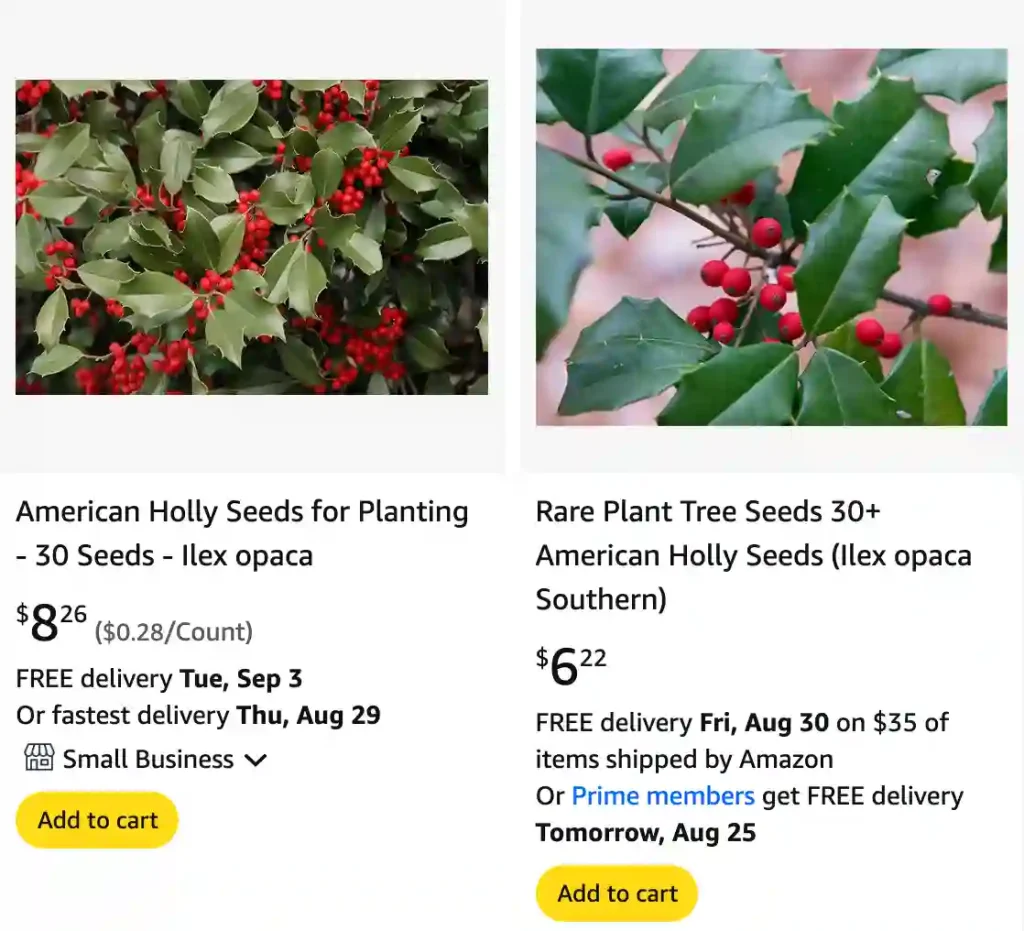
FAQs About American Holly
I’ve always had a soft spot for American Holly (Ilex Opaca), with its glossy, evergreen leaves and vibrant red berries. Over the years, I’ve gathered a wealth of information about this charming tree. Here are the answers to some of the most frequently asked questions about American Holly.
Plant Family: Aquifoliaceae – 569 Species in Genus Ilex – Holly Tree
How Fast Does American Holly Grow?
American Holly grows at a moderate rate. On average, it adds about 6 to 12 inches of growth per year. This steady growth rate means you’ll have time to enjoy its beauty as it matures, but it also means you need to be patient if you’re hoping for a fast transformation in your garden.
Are American Holly Berries Poisonous?
Yes, American Holly berries are toxic if ingested. They contain compounds that can cause gastrointestinal discomfort, such as nausea and vomiting. While the berries are not usually lethal, it’s best to keep them away from children and pets.
Are American Holly Trees Deer Resistant?
American Holly is relatively deer resistant, though not completely. Deer generally avoid it due to its tough, spiky leaves, but in times of scarcity, they might munch on it. In my garden, I’ve found that occasional browsing does happen, but it’s not a major problem.
How Tall Do American Holly Trees Grow?
American Holly trees can grow quite tall, reaching heights of 15 to 30 feet. In ideal conditions, some can even exceed 40 feet. Their dense foliage and towering presence make them excellent for providing privacy and shade.
How to Plant American Holly?
When planting American Holly, choose a location with well-draining soil and partial to full sun. Dig a hole twice as wide as the root ball and just as deep. Place the tree in the hole, making sure the top of the root ball is level with the surrounding soil. Backfill with soil, water thoroughly, and apply mulch around the base to retain moisture.
How to Prune American Holly?
Pruning American Holly should be done in late winter or early spring before new growth begins. Remove any dead or diseased branches and shape the tree to maintain a balanced form. For a more formal look, you can also prune to create a more structured shape.
How to Root American Holly Cuttings?
To root American Holly cuttings, take semi-hardwood cuttings in late summer or early fall. Dip the cut ends in rooting hormone and plant them in a mix of peat and perlite. Keep the cuttings in a warm, humid environment and ensure they receive indirect light. Roots should develop in about 6 to 8 weeks.
Is American Holly Invasive?
American Holly is not considered invasive in most areas. It’s native to the southeastern United States and is well-suited to its environment. However, it can spread aggressively in certain conditions, so it’s wise to monitor its growth and manage it as needed.
When to Plant American Holly?
The best time to plant American Holly is in the fall or early spring. Planting during these seasons gives the tree ample time to establish its roots before the heat of summer or the cold of winter sets in.
Where to Buy American Holly?
American Holly can be purchased from garden centers, nurseries, and online retailers. When buying, look for healthy, well-established trees with vibrant foliage and a strong root system.
Are American Holly Berries Edible?
No, American Holly berries are not edible. They are toxic and should not be consumed. They are primarily ornamental and can add a festive touch to your landscape during the winter months.
Are American Holly Trees Coniferous or Deciduous?
American Holly trees are evergreen, meaning they are not deciduous. Their leaves remain green throughout the year, providing year-round color and interest in the garden.
Are American Holly Trees Hardwood?
Yes, American Holly trees produce hardwood. The wood is dense and heavy, which makes it valuable for woodworking and crafting. However, due to its slow growth rate, it’s not commonly harvested.
Can American Holly Grow as a Shrub?
Yes, American Holly can be grown as a shrub, especially when pruned to maintain a smaller size. In fact, many people use it as a hedge or privacy screen due to its dense foliage and attractive appearance.
Can American Holly Grow in Shade?
American Holly prefers partial to full sun, but it can tolerate some shade. It’s best to plant it in a location where it will receive at least a few hours of sunlight each day to promote healthy growth and berry production.
American Holly vs. Nellie Stevens Holly
American Holly and Nellie Stevens Holly (Ilex x ‘Nellie R. Stevens’) are often compared due to their similarities. Nellie Stevens is a hybrid known for its faster growth and larger berries, while American Holly has a more traditional, native appearance and slower growth.
American Holly vs. English Holly
American Holly (Ilex opaca) and English Holly (Ilex aquifolium) differ mainly in their geographic origin and leaf shape. English Holly has spiny leaves and is more commonly used in holiday decorations, while American Holly has a broader range of leaf shapes and is suited to North American climates.
American Holly vs. Chinese Holly
Chinese Holly (Ilex cornuta) differs from American Holly in its leaves and berry types. Chinese Holly has more varied leaf shapes and often produces berries with a more pronounced red color. American Holly, on the other hand, has a more traditional appearance with its glossy, spiky leaves.
American Holly vs. Deciduous Holly
Deciduous Holly, such as Winterberry (Ilex verticillata), loses its leaves in winter, unlike the evergreen American Holly. Both have attractive berries, but the deciduous variety provides a seasonal change in appearance.
American Holly vs. Dragon Lady Holly
Dragon Lady Holly (Ilex x ‘Dragon Lady’) is a hybrid with spiky, dark green leaves and a more compact form. It’s known for its resilience and dense foliage, while American Holly is larger and more traditional in appearance.
American Holly vs. Foster Holly
Foster Holly (Ilex x attenuata ‘Foster’) is a hybrid that grows faster and has a more pyramidal shape compared to the more rounded American Holly. Both are excellent choices for creating a dense hedge, but Foster Holly has a slightly more uniform appearance.
American Holly vs. Leyland Cypress
Leyland Cypress (x Cupressocyparis leylandii) is a fast-growing evergreen that serves as a privacy screen, unlike the slower-growing American Holly. Leyland Cypress has a more delicate foliage and is not as hardy in cold climates as American Holly.
American Holly vs. Magnolia
Magnolia trees, such as Southern Magnolia (Magnolia grandiflora), have large, showy flowers and large leaves, differing greatly from the small, glossy leaves and berries of American Holly. Magnolias are also more suited to warmer climates, whereas American Holly is hardy in cooler regions.
American Holly vs. Red Tip
Red Tip Photinia (Photinia x fraseri) has bright red young leaves and is often used for hedging. It contrasts with American Holly’s evergreen foliage and slower growth. Red Tip is more suited for warmer climates compared to the cold-hardy American Holly.
American Holly vs. Yaupon
Yaupon Holly (Ilex vomitoria) is smaller and has a more irregular shape compared to the tall, upright American Holly. Yaupon Holly is also known for its caffeine-containing leaves, which are used in traditional teas, while American Holly is primarily ornamental.
These FAQs cover a broad range of topics about American Holly, from growth rates to comparisons with similar plants. If you have any more questions or need additional details, feel free to ask!
If i die, water my plants!



